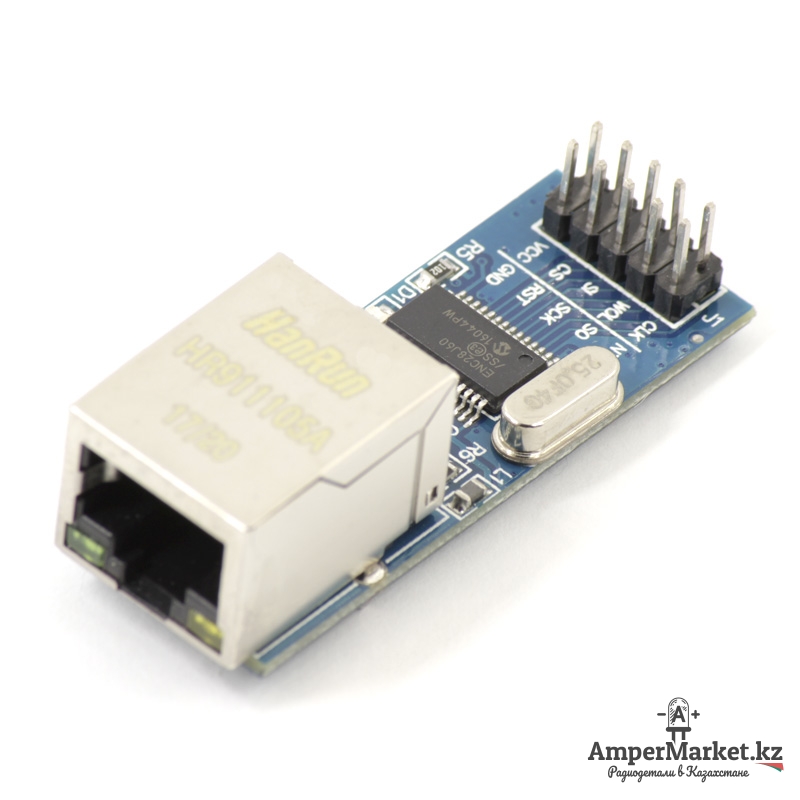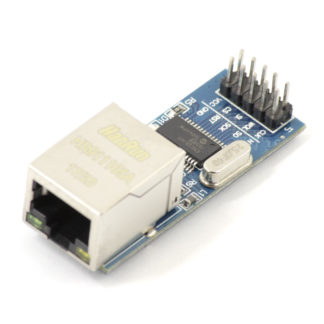Сетевой Ethernet модуль на ENC28J60, как следует из названия, предназначен для организации передачи данных по сети между различными устройствами, при этом он работает как в локальной сети TCP/IP, так и в сети Internet. Модуль основан на микроконтроллере ENC28J60, максимальная тактовая частота которого составляет 25 МГц. Все функции по работе с сетевыми протоколами возложены на него, Arduino остаётся только отправлять и принимать пакеты данных.

Аппаратные возможности модуля ENC28J60 и соответствующая программа микроконтроллера позволяют создать простой веб-сервер. Модуль связывает управляющий контроллер через интерфейс SPI с сетью TCPIP. ENC28J60 Ethernet модуль для Ардуино может служить не только частью прибора автоматики, но и наглядным пособием для изучения сети TCP/IP и методов построения веб-сервера.
На плате имеется разъем RJ-45, включающий в себя трансформатор, обеспечивающий гальваническую развязку модуля от кабеля TCP/IP, и 2 светодиода, свечение которых сообщает о обмене данными. Кварцевый резонатор модуля рассчитан на частоту 25 МГц. Разъем подключения к управляющему микроконтроллеру (например, к плате Arduino) имеет 10 контактов:
- VCC – питание, «+»;
- GND – питание, «земля»;
- SCK – тактирование (SPI);
- SO – MISO, выход данных (SPI);
- SI – MOSI, вход данных (SPI);
- CS – вход выбора микросхемы (SPI);
- INT – выход прерывания при приеме пакета;
- RESET – сброс;
- CLKOUT – Clock output, выход тактирования;
- WOL – прерывание.
Подключение к Arduino Uno:

- VCC → 3.3V;
- GND → GND;
- SCK → 13;
- SO → 12;
- SI → 11;
- CS → 10.
Пример: testDHCP
|
1 2 3 4 5 6 7 8 9 10 11 12 13 14 15 16 17 18 19 20 21 22 23 24 25 26 27 28 29 30 31 32 |
#include <EtherCard.h> static byte mymac[] = { 0x74, 0x69, 0x69, 0x2D, 0x30, 0x31 }; byte Ethernet::buffer[700]; void setup () { Serial.begin(57600); Serial.println(F("n[testDHCP]")); Serial.print("MAC: "); for (byte i = 0; i < 6; ++i) { Serial.print(mymac[i], HEX); if (i < 5) Serial.print(':'); } Serial.println(); if (ether.begin(sizeof Ethernet::buffer, mymac) == 0) Serial.println(F("Failed to access Ethernet controller")); Serial.println(F("Setting up DHCP")); if (!ether.dhcpSetup()) Serial.println(F("DHCP failed")); ether.printIp("My IP: ", ether.myip); ether.printIp("Netmask: ", ether.netmask); ether.printIp("GW IP: ", ether.gwip); ether.printIp("DNS IP: ", ether.dnsip); } void loop () {} |

Пример: backSoon
|
1 2 3 4 5 6 7 8 9 10 11 12 13 14 15 16 17 18 19 20 21 22 23 24 25 26 27 28 29 30 31 32 33 34 35 36 37 38 39 40 41 42 43 44 45 46 47 48 49 50 51 52 53 54 55 56 57 58 59 60 61 |
#include <EtherCard.h> #define STATIC 0 // set to 1 to disable DHCP (adjust myip/gwip values below) #if STATIC // ethernet interface ip address static byte myip[] = { 192,168,1,64 }; // gateway ip address static byte gwip[] = { 192,168,1,1 }; #endif // ethernet mac address - must be unique on your network static byte mymac[] = { 0x74,0x69,0x69,0x2D,0x30,0x31 }; byte Ethernet::buffer[500]; // tcp/ip send and receive buffer const char page[] PROGMEM = "HTTP/1.0 503 Service Unavailablern" "Content-Type: text/htmlrn" "Retry-After: 600rn" "rn" "<html>" "<head><title>" "AmperMarket Test Page" "</title></head>" "<body>" "<h3>AmperMarket Test Page</h3>" "<p><em>" "BackSoon sketch<br />" "Your Text" "</em></p>" "</body>" "</html>" ; void setup(){ Serial.begin(57600); Serial.println("n[backSoon]"); // Change 'SS' to your Slave Select pin, if you arn't using the default pin if (ether.begin(sizeof Ethernet::buffer, mymac, SS) == 0) Serial.println( "Failed to access Ethernet controller"); #if STATIC ether.staticSetup(myip, gwip); #else if (!ether.dhcpSetup()) Serial.println("DHCP failed"); #endif ether.printIp("IP: ", ether.myip); ether.printIp("GW: ", ether.gwip); ether.printIp("DNS: ", ether.dnsip); } void loop(){ // wait for an incoming TCP packet, but ignore its contents if (ether.packetLoop(ether.packetReceive())) { memcpy_P(ether.tcpOffset(), page, sizeof page); ether.httpServerReply(sizeof page - 1); } } |











